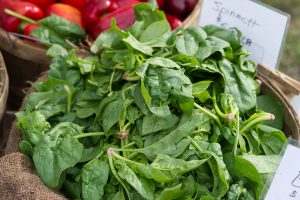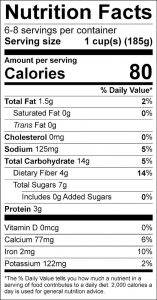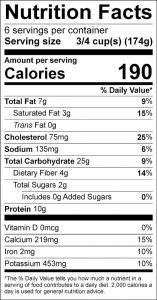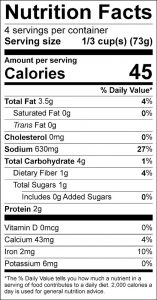Bulletin #4180, Vegetables and Fruits for Health: Greens

Revised and updated by Extension Professor Kathleen Savoie and Extension Educator Kate Yerxa, University of Maine Cooperative Extension; Originally developed by Extension Nutrition Specialist Nellie Hedstrom, University of Maine Cooperative Extension.
For information about UMaine Extension programs and resources, visit extension.umaine.edu.
Find more of our publications and books at extension.umaine.edu/publications/.
The word “greens” is used to describe many green, leafy vegetables. These include beet greens, spinach, and dandelion greens, as well as members of the cabbage family like kale, collard greens, turnip greens, and mustard greens. The availability of greens varies by type. The peak season for dandelion greens in Maine is early spring, beet greens are available beginning in late June, and other greens are available throughout the summer into late fall.
Nutrition Information
Greens are an excellent source of vitamin A. They are also a good source of vitamin C, vitamin K, calcium, and fiber.
Selection
Choose bright green, crisp, fresh-looking leaves. Avoid wilted, yellowed, and insect-damaged leaves.
Flavor and Storage of Various Greens
| Type of Green | Flavor | Recommended Storage |
|---|---|---|
| Kale | Mild | Best when stored in cold temperatures. Place greens in a plastic, perforated bag in the refrigerator. Use within 2 to 3 days. |
| Collard greens | Strong | Store in the crisper drawer of the refrigerator, or in an open or perforated plastic bag. Use within one week. |
| Mustard greens | Strong | Wrap tightly in plastic and keep in the refrigerator. Use within 2 to 3 days. |
| Beet greens | Mild | Can be stored either in a plastic bag in the refrigerator, or wrapped in a damp paper towel. Use within 2 to 3 days. |
| Spinach | Mild | Store in the refrigerator in a plastic bag for up to 4 days. |
| Dandelion greens | Strong/tangy | Wrap in a damp paper towel, place in a perforated plastic bag, and store in the refrigerator. |
| Swiss chard | Mild | Store unwashed greens, wrapped in plastic, in the crisper drawer of the refrigerator. Use within 2 days — wash before using. |
| Turnip greens | Strong | Wrap greens in a damp paper towel, then place in a perforated plastic bag and refrigerate. Use within 4 to 7 days. |
Preparation
All greens need a thorough washing in lukewarm water to remove soil. Fill a large bowl with lukewarm water and move the greens up and down in the water several times. Then lift the greens out of water so that any sand or soil will remain on the bottom of the bowl. Some greens may require two washings. After washing, pat greens with a clean towel or use a salad spinner to dry them. Leave young greens whole, but cut the stems off of larger, older greens.
Mild greens, such as spinach, kale, and chard can be steamed, boiled, or eaten raw. If you choose to cook them, such greens should be cooked quickly to preserve their bright green color. Stronger-flavored greens, such as collard, mustard, and turnip greens, should be blanched before cooking or adding to soups or stews, to remove objectionable odors and bitter flavors. (Refer to blanching instructions below.) Remember that greens will cook down to between a quarter and a half of their original volume, so buy accordingly.
Raw: Raw greens, with their varied taste, make great additions to salads. Choose spinach, young beet greens, or dandelion greens.
Steaming: Choose spinach, beet greens, turnip greens, or mustard greens. To steam, bring one inch of water to boil in the bottom of a pan. Place a colander or steaming basket in the pan. Toss in the vegetables and cover tightly. Reduce heat to medium-low, making sure it is high enough to keep the water bubbling.
Blanching: To blanch, place two gallons of water in a large pan and heat to a rapid boil. Put the greens in a wire basket and place them in the boiling water. Boil the greens for no more than two minutes. After two minutes, immediately remove the basket of greens from the boiling water and place it in ice-cold water. Cool the greens for at least two minutes, and then drain.
Sautéing: To sauté greens, heat a skillet and add a small amount of vegetable oil, such as canola or light olive oil. When oil is hot, add greens. If you are sautéing small leaves, there is no need to cut them, but if you are working with larger greens such as chard, cut them into smaller ribbons. Cook for three to four minutes, stirring occasionally. The volume of leaves will be reduced significantly, and they should be still bright green. Add salt and pepper to taste if desired. Serve immediately.
Other uses for greens: mix greens into omelets, quiches, lasagna, soups, and casseroles.
Spinach Orange Salad
Serves: 6 – 8
6 cups fresh spinach, torn
2 cups other salad greens (romaine, escarole, or leaf lettuce)
1 11-ounce can mandarin orange sections OR 1 cup fresh
orange slices
1 cup fresh mushrooms, sliced (optional)
1 small red onion, sliced and separated into rings
1 cup (8 ounces) water chestnuts, drained (optional)
1/4 cup low-fat French dressing
In a large bowl, combine all ingredients except dressing. Pour on the dressing and toss.
Greens and Rice
Serves: 6
1 pound kale, collard greens, or beet greens, cut into half-inch strips and steamed
2 cups cooked rice (brown or white)
2/3 cup grated cheddar cheese
2 eggs, beaten
2 tablespoons chopped parsley
1/8 teaspoon black pepper
1/4 cup soft, whole-grain bread crumbs
Wash greens and steam until tender. Combine the cooked rice, cheese, and eggs. Add parsley and pepper. In an oiled 8- x 8-inch casserole dish, alternate layers of rice and greens, ending with rice. Top casserole with crumbs. Bake at 350ºF for 30 minutes.
Asian Style Sauté
Serves: 4
1 tablespoon oil—sesame or peanut
2 cloves garlic, minced
1/2 pound greens, coarsely chopped
1 tablespoon vinegar
2 tablespoons soy sauceHeat oil in large skillet. Add garlic and sauté 2 minutes. Add the greens and sauté until just wilted. Remove the skillet from the heat and stir in vinegar and soy sauce. Serve immediately. Great as a side dish or with rice.
Some content adapted with permission from University of Massachusetts Cooperative Extension.
Information in this publication is provided purely for educational purposes. No responsibility is assumed for any problems associated with the use of products or services mentioned. No endorsement of products or companies is intended, nor is criticism of unnamed products or companies implied.
© 2008
Call 800.287.0274 (in Maine), or 207.581.3188, for information on publications and program offerings from University of Maine Cooperative Extension, or visit extension.umaine.edu.
In complying with the letter and spirit of applicable laws and pursuing its own goals of diversity, the University of Maine System does not discriminate on the grounds of race, color, religion, sex, sexual orientation, transgender status, gender, gender identity or expression, ethnicity, national origin, citizenship status, familial status, ancestry, age, disability physical or mental, genetic information, or veterans or military status in employment, education, and all other programs and activities. The University provides reasonable accommodations to qualified individuals with disabilities upon request. The following person has been designated to handle inquiries regarding non-discrimination policies: Director of Equal Opportunity and Title IX Services, 5713 Chadbourne Hall, Room 412, University of Maine, Orono, ME 04469-5713, 207.581.1226, TTY 711 (Maine Relay System).




